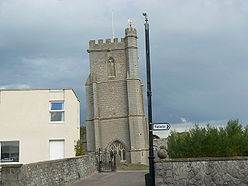- St Andrew's Church, Burnham-on-Sea
-
St. Andrew's Church 
General information Town or city Burnham-on-Sea Country England Construction started 1305 Completed 1314 St Andrew's Church is the Church of England parish church of Burnham-on-Sea in the English county of Somerset. Of medieval origins, the church is a grade I listed building, well known for its leaning tower.
Contents
History
There has been a church on this site since the late 11th century. Between 1305 and 1314 the original church was either replaced or enhanced; the parts of that church that still stand are the south transept, the south door arch, the holy water stoop and the consecration cross.
Leaning tower
The leaning tower, 78ft high, gets a lot of attention from tourists. Apparently if a plumb line is dropped from the north side of the tower it would fall 3 feet away from the building. This major leaning is believed to be caused by the poor foundations.
During the 18th century a light was placed on the tower to guide fishing boats into the harbour. A local vicar, either John Goulden in 1764 or Walter Harris in 1799, raised a subscription amongst the local population to replace the light on the church. A four storey round tower was built next to the church, being completed in 1801.[1] This was taken over and improved by Trinity House,[2] in 1829. Funds from the sale were used by the vicar, Rev David Davies, to improve the area in an attempt to create a spa town.[1] Trinity House operated the lighthouse until 1832 when it became inactive and was replaced by the High and Low lighthouses. The round tower was later shortened to two storeys, to prevent any confusion with the High Lighthouse.[3]
The tower holds a ring of eight bells hung for change ringing. The present ring contains bells cast at various dates by the Whitechapel Bell Foundry.[4]
Sculptures
A number of marble carvings designed by Sir Christopher Wren, for the private chapel in the Palace of Westminster can be now seen in the church.[5] These sculptures formed part of an altar commissioned by James II in 1685 and were sculpted by Grinling Gibbons and his assistant Arnold Quellin, a Belgian artist of Antwerp. After having originally been taken to Westminster Abbey in 1706, where they were placed behind the High Altar, they were moved to Burnham in 1820 when the Bishop of Rochester (also then vicar of Burnham-on-Sea), acquired them.
What one sees at Burnham is only part of the whole design; the main panels are behind the altar with the remainder of the fragments displayed at various places in the main body of the church. They first occupied the whole of the east wall behind the altar.
References
- ^ a b "Burnham on Sea Conservation Area Character Appraisal". Sedgemoor Council. pp. 12. http://www.sedgemoor.gov.uk/media/pdf/j/3/Public_Consultation_Draft.pdf. Retrieved 26 April 2010.
- ^ Farr, Grahame (1954). Somerset Harbours. London: Christopher Johnson. pp. 91.
- ^ "Lighthouses". Burnham on Sea.com. http://www.burnham-on-sea.com/lighthouses.shtml. Retrieved 5 April 2010.
- ^ "Burnham on Sea—S Andrew". Dove's Guide for Church Bell Ringers. 7 October 2009. http://dove.cccbr.org.uk/detail.php?searchString=Burnham+on+Sea&Submit=++Go++&DoveID=BURNHAMONS. Retrieved 29 April 2010.
- ^ "Church of St. Andrew". Images of England. http://www.imagesofengland.org.uk/details/default.aspx?id=433731. Retrieved 2006-12-10.
- The proceedings of the Somerset Archaeological and Natural History Society - Vol. LXXXI - 1935 - pp. 127-132 by AW Vivian-Neal M.C., F.S.A. gives an account of the history behind this statuary.
External links
Categories:- Church of England churches in Somerset
- Grade I listed buildings in Somerset
- Grade I listed churches
Wikimedia Foundation. 2010.
